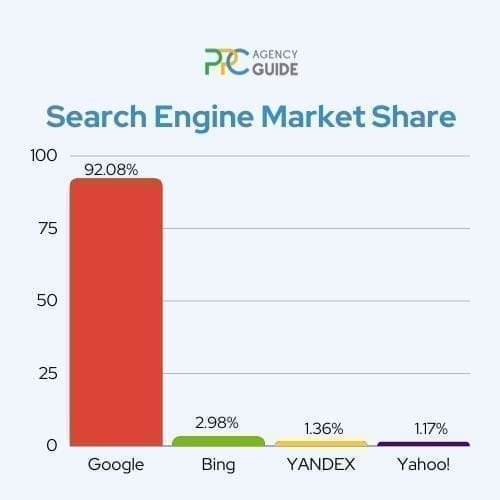
The battle between Google Ads vs. Microsoft Advertising is one of our time’s oldest and greatest rivalries, seemingly dating as far back as pay-per-click advertising itself. While both are great advertising options that can help you attract potential customers, each shines in unique ways.
Give us a few minutes, and we’ll walk you through how running ad campaigns on each platform differs, the typical results businesses achieve, and how to decide which advertising strategy is best for your needs.
Understanding the PPC Landscape: Microsoft and Google Ads
Before we dig into the Google Ads vs. Microsoft Advertising debate, let’s go over some basics on how pay-per-click (PPC) ads work and where these two PPC advertising networks come into play.
How PPC Works

As the name suggests, PPC ads are a form of paid advertising in which your business pays each time someone clicks on one of your ads. There are usually four parties involved:
- The advertiser (you)
- The publisher (usually a third-party website or search engine that displays your ad)
- The ad platform (Google, Microsoft, etc.)
- The user (the person viewing your ad)
Rather than purchasing ad space directly from a third-party website (publisher), advertising platforms (Google, Bing, etc.) make the arrangements for you.
Most large ad platforms work on an automated bidding system. That means you set up your ads, including bidding criteria, and an auction takes place each time an ad is to be displayed. Then, the auction winner’s ad is displayed. Bids, the quality of the ad, details about the user, and other factors all work together to determine which ad wins the auction.
Because auctions are not won or lost solely on bidding strategies and how much you’re spending, the platform and how it’s programmed to work will significantly impact when your ad displays too.
Types of Google and Microsoft Ads
Display and search ads are two of the most common ad types leveraged in PPC strategies.
- Display Ads: Also referred to as rich media ads, display ads combine text and visuals such as images and videos. They can appear on virtually any digital property, such as a website or mobile app. Banner ads are a common example.
- Search Ads: As a form of search engine marketing (SEM), search ads only appear on search engine results pages (SERPs). Although images are sometimes included, they’re often text-based to help them blend in with organic search results better. Although you will find search ads on sites like Facebook or Amazon, they’re most often associated with platforms wholly dedicated to search, such as Google Search and Bing.
Intro to Google Ads (Formerly AdWords)
Although some people still refer to Google AdWords (for advertisers) or AdSense (for publishers), the company officially rebranded under the single name of Google Ads in 2018. The platform’s search ads appear in Google Search, while its display ad network is comprised of more than two million websites globally.
Intro to Microsoft Advertising (Formerly Bing Ads)
Prior to 2019, Microsoft Advertising was known as Bing Ads. The new name more accurately represents the broad nature of the advertising platform, as search ads placed through it may now appear on Bing, AOL, Yahoo!, and syndicated partner sites like MSN.com, as Microsoft reports. Although the company is tight-lipped about the size of its display network, it’s no doubt sizable and diverse.
Comparison of Google Ads vs. Microsoft Advertising
Now that we’ve covered the background let’s compare Google Ads and Microsoft Advertising a bit. Below, we’ll look into the experience each offers, reach, demographics, cost, and performance so it’s easier to see which fits into your marketing strategy best.
Advertiser Experience
From the advertiser side of things, both Google and Microsoft Ads work remarkably similarly. In fact, you can even import your Google Ad campaigns directly into Microsoft Advertising.
Keywords
Both platforms address keywords the same. You can use exact, phrase, and broad match modifiers to determine which search queries trigger your search ads to display. You can also use negative keyword targeting to prevent your ads from displaying in specific searches.
Both also offer dynamic search ads, which allow ads to display based on the content of your website rather than specific keywords, which can help brands reach a wider audience.
Content
While there have historically been differences in the types of content allowed, character counts, and ad formatting, both are essentially the same today.
Targeting
Microsoft Ads offers an advantage when it comes to audience targeting. While you can choose network, location, scheduling, language, and other preferences, this is done at the campaign level. This means all campaign ads share the same target audience. Microsoft offers more granular targeting, allowing you to adjust settings at the ad group level. That way, you can target different groups based on blocks of keywords and their corresponding ads.
User Experience

Microsoft Bing and Google offer a very similar search experience. Both feature bold headings, descriptions, extensions, and even images at times. However, when we look at the SERPs side by side, there are some key differences. For instance, even though the total number of links and extensions doesn’t differ much, Bing tends to make them more pronounced. Bing also shows contact information more often and features a large graphical ad in the right column. Meanwhile, Google differentiates itself by displaying company logos with each search result.
The way the results display will vary with each query. Sometimes Google results appear more like the Bing sample here and vice versa. However, the results shown are fairly typical of the search engines.
Reach
One of the biggest arguments in the Google Ads vs. Microsoft Advertising debate is reach. To be clear, you will not find a shortage of traffic on either platform. However, Google is the clear forerunner in terms of the total number of people you can reach.
Display Network Size
Microsoft doesn’t specify how many sites participate in its display ad network. Conversely, Google claims to have over two million participating websites.
Search Engine Market Share
In terms of search volumes, Google stands heads above all others, with the greatest percentage of users heading to the search engine for queries. As StatCounter reports, market share figures are:
- Google: 92.08%
- Bing: 2.98%
- YANDEX: 1.36%
- Yahoo!: 1.17%
- Baidu: 0.94%
- DuckDuckGo: 0.56%

Audience Demographics
Due to the significant number of people leveraging both search engines, you can reach a broad audience on either of them. However, Google might be slightly better for those trying to reach a female audience, and Microsoft Bing may be better for those trying to reach a male audience based on SimilarWeb demographics.

It’s worth noting that Google has not released audience-specific demographics, but Microsoft has. The information released strongly suggests that Microsoft may offer greater penetration for businesses trying to reach people who:
- Have college degrees
- Have higher incomes
- Are married
- Have children
However, because Google offers greater volume and has not released similar data, either platform can likely meet your needs, especially if you’re targeting well.
Performance Analysis
Two areas of major concern with performance are click-through rates and conversion rates.
Click-Through Rate (CTR)
Click-through rate, usually shortened to CTR, refers to the percentage of people who view an ad that clicks it. The figure varies widely by industry, so we’ll look at average click-through rates overall.
- Google CTR: The average Google Search Ad CTR is 1.91 percent, while the display network’ CTR is 0.35 percent, per WordStream research.
- Microsoft CTR: The average CTR is 2.8 percent, per WordStream. Data is not split by search and display.
As you can see, Microsoft advertising beats Google Ads in the average CTR category. While some of this could be due to the quality of the ad algorithm, this likely has more to do with the additional ad space afforded by Bing.
Conversion Rate (CVR)
Conversion rate, sometimes shortened to CVR, is the percentage of people who complete their goal after clicking an ad. Again, the figure differs by industry, so we’ll look at average conversion rates overall.
- Google CVR: The average Google Ads conversion rate is 3.75 percent for search and 0.77 percent for display.
- Microsoft CVR: The average conversion rate for Microsoft advertising is 2.94 percent, per WordStream.
Google technically comes out on top in the conversion rate category. However, if Microsoft’s data was split, it could potentially beat out Google because the numbers are quite close. Moreover, many advertiser variables, including landing page experience and call-to-action (CTA), influence this statistic.
Cost Analysis
Two areas of significant concern with cost are cost-per-click and cost-per-action.
Cost-per-Click (CPC)
Cost-per-click, usually shortened to CPC, refers to the amount an advertiser pays each time a user clicks their ad.
- Google CPC: The average cost-per-click for Google Search is $2.69. which display comes in at $0.63, as WordStream reports.
- Microsoft CPC: The average cost-per-click for Microsoft Advertising is $0.84, per Microsoft, while WordStream clocks it at $1.54.
Based on the data available, businesses save about one-third going with Microsoft Advertising over Google Ads. This is likely because there are more ad spaces available on Bing and less competition for keywords overall.
Cost-per-Action (CPA)
Cost-per-action, or CPA, is the total amount paid for each conversion. Again, this varies by industry, so we’ll look at overall figures.
- Google CPA: The average Google cost-per-action is $48.96 for search and $75.51 for display.
- Microsoft CPA: The average Microsoft CPA cost-per-action is $41.44.
As you can see, Microsoft Advertising costs considerably less due to the lower CPC.
Which is Better: Google Ads vs. Microsoft Advertising

We can look at general data and see that Google Ads triumphs when it comes to reach, while Microsoft Advertising is the clear forerunner in performance and cost. Yet, that doesn’t necessarily mean one is better than the other. These are generalities across all industries and businesses. Your business could be the exception and perform better with Google Ads, or you might need its vast network to reach your target audience. Equally, you’re quite likely to receive better results and pay less by going with Microsoft Advertising. Therefore, your best bet is to include both in your marketing strategy.
By working with both advertising platforms, you can learn which provides better results for your business, diversify your marketing strategy, and maximize ROI.
Get Help with Your Google and Microsoft Ads
Regardless of which platform you select, you’ll need a PPC expert to ensure you’re getting the best results possible. We’re happy to match you with a PPC agency specializing in your industry and preferred networks. To learn more or get started, request a complimentary consultation.
Additionally, if you are considering other platforms, you might find our guide on Amazon Ads insightful for expanding your PPC strategy.


















